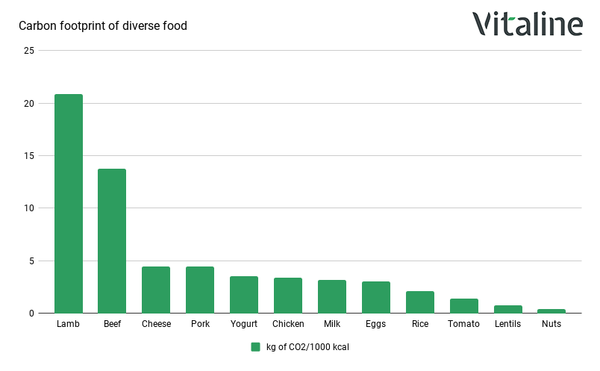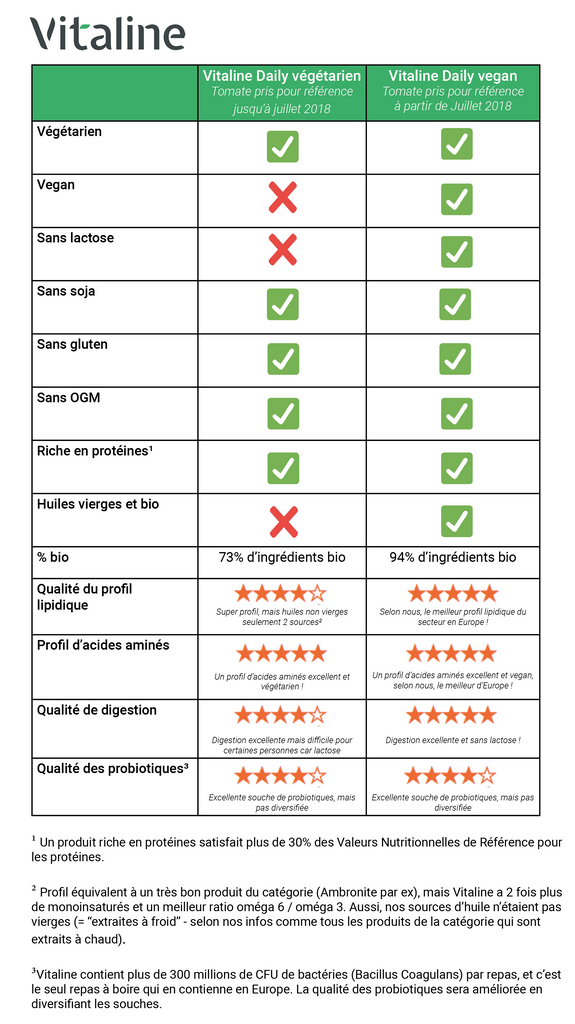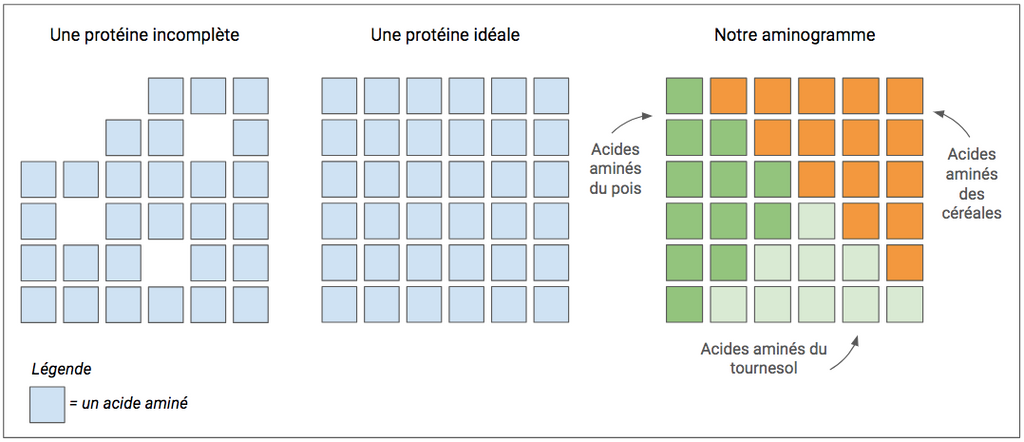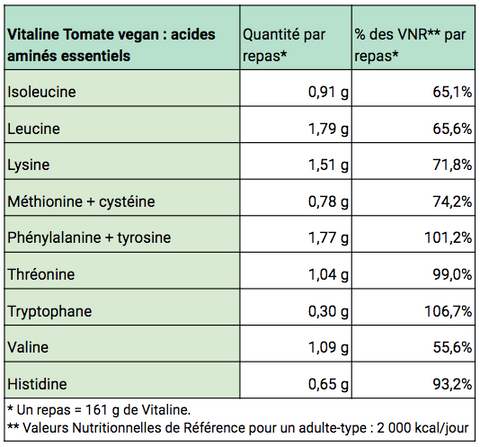The scenes of the development of our first 100% vegetable version
We already announced you a few weeks ago, our first VEGAN version has just released! And it's Vitaline tomato who opens the ball. A 100% vegetable version, with the taste and nutritional performance of Vitaline.
We are therefore passing from vegetarian (without meat but with animal products, here milk proteins) to Vegan, which does not contain any products of animal origin. Vitaline Tomato is our first vegan recipe, before moving the entire range.
We managed the challenge to propose A product still performant nutritionally and good taste, using only vegetable sources.
- Why Vitaline Vegan?
- Nutritional qualities of Vitaline Vegan
- Why develop a quality vegan product is not easy
- And after ? Declination of the Daily range
Why Vitaline Vegan?
Even though we had already started our approach by offering vegetarian products, we wanted to progress again by proposing Vitaline Vegan for two reasons: environmental impact and health impact.
- Decrease your meat consumption has a positive impact on the environment :

- Consume more plant products is good for health.
- The consumption of vegetable products is associated with a lower risk of lower cardiovascular and inflammatory diseases1,2.
- We also decreases its risk of exposure to certain endocrine disruptors By limiting its consumption of animal products.
Vitaline Vegan allows you to reduce your carbon footprint and be healthier. 💪🏼😃
For the most pressed, here is a summary of the differences between Vitaline Vegetarian version and Vitaline Version Vegan:

Nutritional qualities of Vitaline Vegan
This Vegan passage also allowed us to challenge our formulations to improve them and continue to progress. We take as reference here Vitaline tomato vegan, since this is the first recipe we have developed.
- The best lipid profile in Europe
For this VEGAN version, we used three organic virgin oils, extracted cold, which we are to our knowledge the only ones to offer on the European market.
The majority (80%) of Vitaline's lipids come from these oils that we have carefully selected: rapeseed oil, oleic sunflower oil and linen oil. This combination of oils with very different fatty acid profiles makes it possible to obtain excellent values, difficult to achieve with the use of a single oil: less saturated fatty acids and more omega 3. Our omega 3 from vegetal sources only, they are in the form of ALA3, which are then converted by the body in EPA4 and DHA5.
We thus get the best lipid profile in Europe, further improved compared to that of our vegetarian version, which was already excellent.
We will return in more detail on this subject within two weeks in an article dedicated to the lipid profile of Vitaline.
- Better digestibility thanks to the removal of lactose
We have so far used a lactose support, which we have therefore replaced by a support of vegetable origin (cassava). Remember that an oil needs a support to be able to be in the form of a powder. We opted for cassava (technically "unrefined handling syrup and bio", either dehydrated and hydrolyzed cassava), which is a much more qualitative support than maltodextrins from corn and wheat because it has a equivalent dextrose (Similar to glycemic index) much lower.
Lactose is poorly digestible for most people and can be the cause of bloating or digestive discomfort6. By removing lactose support, We removed an allergen and improved Even more the digestibility of our product. And this, replacing it with a quality support.
- Several sources of vegetable protein to obtain an excellent amino acid profile, avoiding soybeans
Compared with animal proteins, vegetable proteins are less bioavailable7 for the body. For example, the digestibility of the proteins of a lentil dish is between 50% and 80%, against more than 90% for the proteins of a dairy product. The absorption of vegetable proteins is reduced by the presence of undigestible compounds found in plants. This is why we used flours and concentrates, which have higher protein contents and contain fewer undigestible compounds, and are therefore more absorbed by the body.
Vegetable proteins generally have lower levels of essential amino acids than animal proteins. To keep an excellent amino acid profile, we chose to incorporate A concentrate of organic pea proteins, containing about 80% protein and a protein flour of organic sunflower seeds containing 53% protein. The association of both brings a very good amino acid profile and varying sources.
Cereals (oats, buckwheat) and legumes (peas, sunflower) contain all essential amino acids but in different levels, and their amino acid profiles are complementary. The association of all these ingredients allows us to obtain An excellent amino acid profile, which we think is the best of Europe on Vegan products in our category.
Vitaline Amino Acid Profile Tomato Vegan:

And here is our super aminogram!

It would have been easy to use soy, which is very rich in protein, but we have discarded it from office for two reasons:
- soy contains phytoestrogens : Many researchers have shown a correlation between phytoestrogen consumption and a decrease in fertility. Even if no research has been successful for the moment, suspicion remains strong. L'Handles Recommends a maximum limit of the order of 1 mg of phytoestrogens. It can easily be reached8 When we consume many soybean products such as tofu, soy steaks etc.
- Most of the soybean that is consumed is genetically modified : The French market is almost entirely supplied with imported soybeans9, which comes mainly from American countries (United States, Brazil, Argentina) where the cultivation of GMOs is tolerated. Vitaline is no GMO since the beginning, and will stay it!
So you can count on Vitaline to limit your soybean intake, without being in default of protein :)
- No need to take a complement! Calcium and B12 requirements are satisfied.
By removing milk proteins, the vitamin B12 is automatically removed and the quantities of calcium are reduced. But vitamin B12 is essential for the body, and it does not know how to synthesize it. It is the only vitamin found in our diet only in animal products: people with a vegan regime generally take vitamin B12 supplements to limit any risk of deficiency.
So that Vitaline remains a full meal, we added methylcobalamin, the best absorbed form of vitamin B1210, and calcium citrate, a very available shape for the body.
- Result: a nutritional quality at the top of the European market
We have not found a product on the European market that reaches this nutritional quality: whether it is on the amino acid profile, lipid profile but also carbohydrate, probiotics and the quality of the ingredients.
We prepare full and detailed items about these different points, which we will publish soon on the blog.
Why develop a quality vegan product is not so simple
We have identified three main challenges during this development:
1. Ensure high nutritional qualities using only vegetable sources
Milk proteins alone are sufficient to meet the needs of essential amino acids, unlike vegetable proteins, which must be combined to obtain the same results.
Our solution: As explained earlier, we could have opted for the simplest solution by replacing animal proteins with soy. We did not do it. We took care of Select the best sources of vegetable protein and build a balanced amino acid profile by combining several types of vegetable proteins.
2. Gustative quality
Vegetable proteins have an astringent taste and a granular texture, unlike milk proteins that bring a macked taste and a smooth texture.
Our solution: We also managed to propose A tasty recipe By attenuating the taste of vegetable proteins Without adding or aroma, no more sugar or fat only in other versions of Vitaline. The recipe for this specific development is held secret 😉
3. Satisfy the needs in B12 and calcium
... which were brought mostly by milk proteins.
Our solution: There are several forms of B12, some of which are not bioavailable and therefore do not produce any effect. That's why we added from the methylcobalamine and Calcium citrate, who are the best absorbed forms by our body, and therefore effective.
In conclusion
The development of our first VEGAN version took time because we wanted to build a quality product and not give way to the facility (such as too many actors on the market). We have led a real job on vegetable proteins to progress and always offer the top of the nutrition.
And after ? Declination of the entire Daily range
Vitaline Tomato is our first vegan recipe. We are currently in phase 2 of the Pilot Program, which means that other versions will still be offered to you. In parallel, we begin to rework our existing Daily recipes (cocoa, almond, red fruit and curcuma carrot) to adapt them to vegan version. The change will gradually get from here in the fall.
While waiting for the other VEGAN versions, Vitaline tomato vegan is available on our website ! Order your bottles to be part of the first to test this new version, including lipid and amino acid profile is the best in Europe.
We are very proud of this new stage crossed for Vitaline, but it's just the beginning! We do not release our efforts to make new improvements again. By purchasing our new products and giving your opinion, you help us progress. Let's continue joining forces to advance nutrition!
References :







